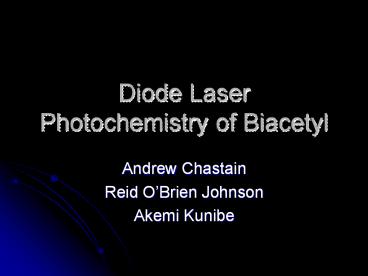Diode Laser Photochemistry of Biacetyl - PowerPoint PPT Presentation
Diode Laser Photochemistry of Biacetyl
397.5 nm diode laser. Reaction chamber. Ocean Optics Spectrometer. Spex Spectrometer. Experimental Setup. Laser Diode. Reaction Chamber. Fiber Optics Cable ... – PowerPoint PPT presentation
Title: Diode Laser Photochemistry of Biacetyl
1
Diode Laser Photochemistry of Biacetyl
- Andrew Chastain
- Reid OBrien Johnson
- Akemi Kunibe
2
Experimental Setup
- 397.5 nm diode laser
- Reaction chamber
- Ocean Optics Spectrometer
- Spex Spectrometer
3
Experimental Setup
Fiber Optics Cable
Laser Diode
Reaction Chamber
Output to Computer
Detector
4
Laser Calibration
- The laser found to be operating over a range of
modes when calibrated using a higher resolution
Spex Spectrometer.
397.0 398.4 nm
5
Biacetyl
- IUPAC 2,3-butanedione
Image Source http//en.wikipedia.org/wiki/ImageD
iacetyl-3D-balls.png
6
Experimental Results
7
Experimental Results
8
Results
- Two peaks were noted at 513.31 and 556.28 nm
- These peaks correspond to energy transitions of
2.41 and 2.22 eV, respectively
9
What does this mean?
- Literature values for fluorescent range are given
as being in the 444.64 - 478.63 nm range. 1 - What else could be happening?
10
Photochemistry
- Photochemical cleavage reactions could account
for shift. - CH3COCOCH3 hv ? CH3CO CH3CO
- and
- CH3COCOCH3 hv ? CH3COCO CH3
11
Expected shift
- Murad, Edmond and Mark G. Inghram calculated the
bond dissociation energies in Aliphatic carbonyl
compounds. - These were found to be 0.49 0.03 eV for the
CH3-CO bond, and 2.84 0.06 eV for the
CH3CO-COCH3 bond. 2
12
Calculated shift
- The energy shifts associated with the two peaks
are 0.70 and 0.88 eV at 513.31 and 556.28 nm,
respectively. The would indicate that the emitted
energy shift is larger than would be expected
from a methyl shearing, and much smaller than a
split down the middle.
13
LIF Spectroscopy
- Since the energy of the laser photons exceeds the
dissociation energy of the bonds, cleave should
be occurring. But the energy lost from either
cleavage reaction would not shift the peaks to
their measured positions.
14
LIF Spectroscopy
- What this means is that the additional shift
might originate from fluorescence of the
fragments. - This spectrum could then be used to better
understand the structural features of the
cleavage fragments.
15
Works Cited
- 1 Brand, J.C.D and A. W.-H. Mau (1974).
Low-Lying Electronic States of Biacetyl. J. Am.
Phys. Chem. Soc. 96.144380-4385. - 2 Murad, Edmond and Mark G. Inghram (1964).
Thermodynamic Properties of the Acetyl Radical
and Bond Dissociation Energies in Aliphatic
Carbonyl Compounds. J. Phys. Chem. 41.2 404-09.
PowerShow.com is a leading presentation sharing website. It has millions of presentations already uploaded and available with 1,000s more being uploaded by its users every day. Whatever your area of interest, here you’ll be able to find and view presentations you’ll love and possibly download. And, best of all, it is completely free and easy to use.
You might even have a presentation you’d like to share with others. If so, just upload it to PowerShow.com. We’ll convert it to an HTML5 slideshow that includes all the media types you’ve already added: audio, video, music, pictures, animations and transition effects. Then you can share it with your target audience as well as PowerShow.com’s millions of monthly visitors. And, again, it’s all free.
About the Developers
PowerShow.com is brought to you by CrystalGraphics, the award-winning developer and market-leading publisher of rich-media enhancement products for presentations. Our product offerings include millions of PowerPoint templates, diagrams, animated 3D characters and more.































